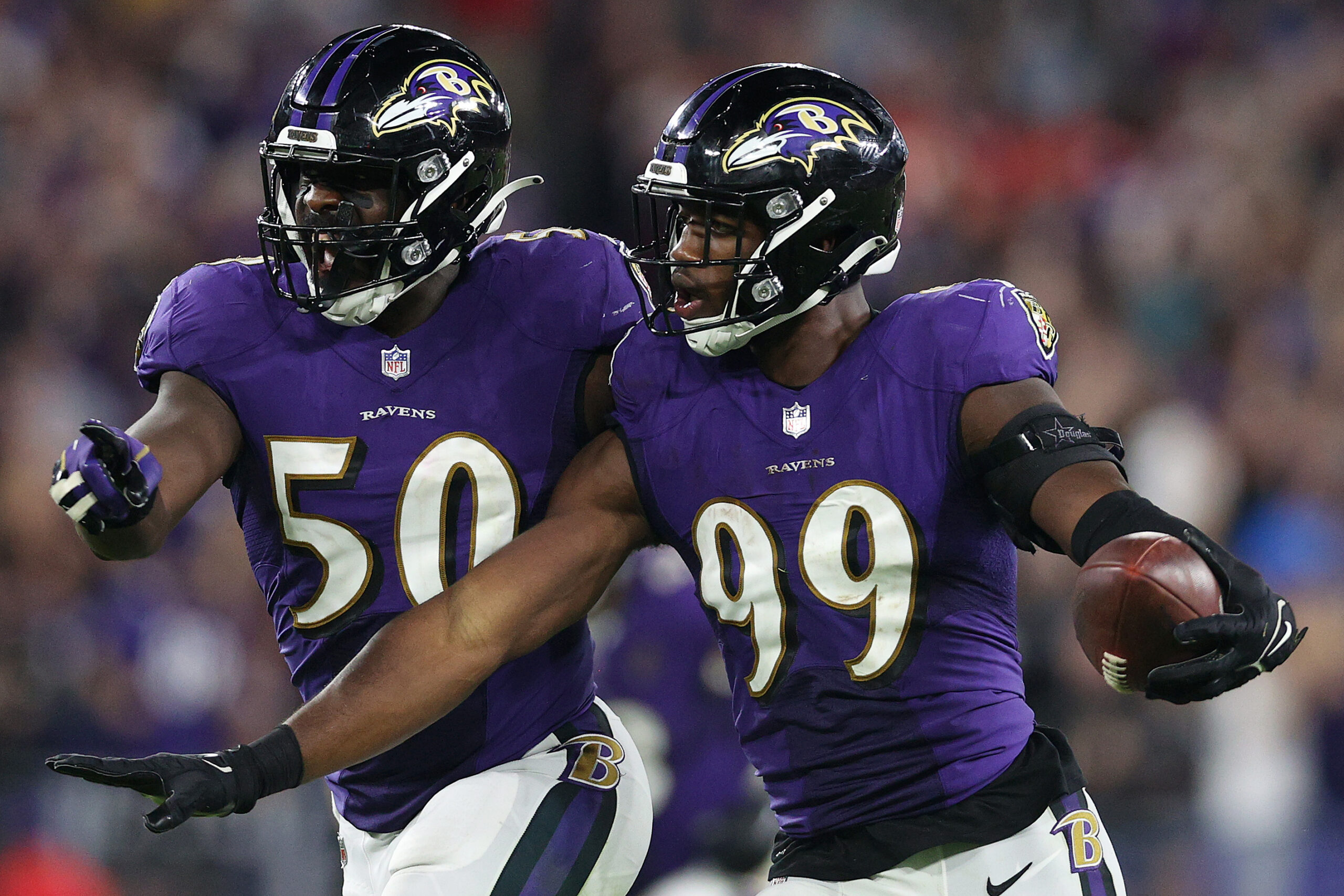Time For an Audit!
Wink Martindale Under The Scope
At the end of any season, especially one that does not end with either a postseason berth or playoff victories, it’s probably best to wait a few days to evaluate the team’s overall performance so emotions aren’t clouding your judgment. I would bank on owner Steve Bisciotti practicing this level of restraint.
Fortunately for me and my deadline, I don’t have that same luxury. But in fairness to myself, I’ve also been waiting to write and say my piece about the defense for a few weeks now. It’s been gnawing at me. I’ve had to resist the urge until the season ended because it would be the only fair that way.
Now we’re here. And I believe it’s time to hit the refresh button on this defense under Don “Wink” Martindale.
Before I get into the specifics, I just want to preface what I’m saying by acknowledging that this isn’t a straightforward evaluation. It’s hard to assess a defense that was missing three out of four of their starting secondary for most of the season. Two of those players – Marlon Humphrey and Marcus Peters – are All-Pro cornerbacks.
Then you have the little “big” losses of players like Derek Wolfe and L.J. Fort. Veterans stalwarts who had more influence on making smart in-game adjustments. Lastly, you also lost an ascending safety in DeShon Elliott.
However, those losses don’t gloss over other problems that have been either above or below the surface before this injury-plagued season. Not all problems by the way are Wink-related issues. But there are some that he needs to be held accountable for, and it’s up to head coach John Harbaugh and general manager Eric DeCosta to take a real look at this unit after a tremendous three-year stretch from 2018-2020.
Gap Assessment
Part I: Front Line Facelift
As part of an audit process for any business evaluation, you should identify gaps before proposing a solution.
The Ravens brass should start with how their defense continues to be so good against the run but doesn’t have nearly the same punch in the pass defense and pass rush departments.
Looking at the final statistics for 2021, the Ravens ranked first overall in run defense and dead last in pass defense. I can see it coming now, when the team discusses their performances and points to the run D as a benchmark and the pass D being related to the injuries in the secondary.
Those would be valid points. If you dig deeper, there are problems with this pass defense that have been there for some time now, specifically since Martindale took over as DC.
This defense still struggles against receivers over the middle of the field. This season they bottomed out, ranking 31st in the league covering the middle. Is it as simple as not having Fort and Elliott to help in coverage? Keeping in mind that those two players have also been a part of other defenses that had the same struggles.
Against the Steelers and Ben Roethlisberger, the middle was a sieve yet again. Pat Freiermuth was the latest in a line of tight ends to carve up the defensive back end when it counted most.
Just the week prior it was Tyler Higbee. It’s one thing to get taken apart by Travis Kelce and Darren Waller earlier in the year. But any tight end with a pulse seems to be a constant problem against this group. Slot receivers too.
Playing the run well has served the team well to an extent. Wink will preach, “we always stop the run first.” Against teams like the Tennessee Titans, it certainly works in their favor. But the bulk of the tier one offenses pass the ball well. If you stop the run on early downs, what good is it when you can’t get off the field in third/fourth and long?
Time and time again, Big Ben was able to do that on Sunday. That’s not even prime Big Ben by the way.
With the game on the line, Pat Freiermuth is out here making plays for the Steelers 😱 pic.twitter.com/anA5cWj63d
— Onward State (@OnwardState) January 9, 2022
The front office and the entire organization has tremendous pride when it comes to stopping the run going back to the 2000 team and that incredible streak of stopping 100-yard rushers. Those days are long gone though. Stopping the run is certainly important but does it need to happen at the cost of incredible personnel resources which could be allocated elsewhere?
It’s hard to overlook the dead weight up front on the front line. Veterans Brandon Williams, Derek Wolfe, and Calais Campbell comprised the famed “Monstars” who ate up Derrick Henry in the playoffs last season. The front office decided to run it back with this group, keeping Campbell and Williams onboard and giving Wolfe an extension.
In 2021, the group fell flat. Wolfe was injured. Campbell visibly looked a step slower as a pass rusher and ended the year with 1.5 sacks. Williams had his ups and downs. Naturally, with Williams and Campbell playing on expiring contracts, they might not be back either way. I believe the team should move on from both and inject much-needed explosiveness on the defensive line.
The seeds could already be planted. I like what I saw from younger defensive tackles Broderick Washington and Isaiah Mack. Justin Madubuike looks like he has the tools to be a more consistent game wrecker but might be confined in this scheme and system.
Beyond those guys, the front office needs to retool and rethink how they want to rebuild this unit. They need playmakers who can get into the backfield and win their one-on-matchups in passing situations. The draft could yield that type of player or multiple players.
The Steelers played the game well on offense. They made sure to run the ball enough times to keep the big boys on the field. And those guys simply couldn’t generate a pass rush when it counted.
Even if it means sacrificing their run defense prowess, it’s time for DeCosta to add some new blood and some much-needed juice to this unit. Could you imagine someone like Christian Barmore playing in this defensive front? Remember when the Ravens had impact players like Trevor Pryce and even Cory Redding who could get that interior pressure and or timely penetration to ruin a play?
The Ravens need their own version of Cam Heyward.
[Related Article: When Philosophy and Personnel Don’t Match]
Part II: Pass Rush Reboot
Admittedly Part I and Part II of the gap assessment are closely connected. But getting back to the coverage side of things…maybe the answer is not to keep adding to the secondary talent and instead keep adding pieces to the front seven.
There is a very real philosophical question that Harbaugh and Wink need to figure out (assuming Wink remains as DC): Is it time to pull back on the blitz and overreliance on the secondary?
At one point during the season after the loss in Pittsburgh, it seemed like Harbaugh was a bit exasperated with Wink’s blitzkreig approach and overreliance on Cover 0, stating:
“[They] hit zero coverage a couple times. You go to the well too many times, and they get you. That’s what happened.”
Maybe this quote isn’t worth scrutinizing. Maybe this was simply a coach who was still coming off the fresh emotions of losing that game. But Harbaugh’s statement has stuck with me for the remainder of the season. And I agree with Harbaugh’s point in a macro sense. There have been plenty of examples and even comments from opposing quarterbacks that confirm they knew what was coming with the Cover 0 looks – Derek Carr and Joe Burrow being the most outspoken this season.
That being said, Wink seemed to adjust more of his coverage style out of necessity in 2021. Not having cornerbacks will do that. He used more combination coverages, gave his corners help by keeping the safeties deep. He also dialed back the all-out blitzes and Cover 0 coverages against the better QBs like Aaron Rodgers, Matthew Stafford and Big Ben in the finale. The result was that the defense still failed to make any plays when it counted, blitz or not.
Can the coaches and staff achieve a middle ground?
I think they can. Which gets back to rethinking the way this defensive line is constructed and adding more to the pass rush talent overall. This offseason presents the perfect time to add more pieces as the team will have better salary cap flexibility compared to 2020 and they’ll actually have a draft choice in the top 15 picks.
Odafe Oweh is a tremendous chip to mold into an elite pass rusher. However, he’s still raw. You saw him hesitate at times on his get off at the snap. His timing wasn’t always there. And frankly, you could argue he wasn’t always used in the most effective ways, in more of a seek and destroy role, as opposed to a hybrid type defender.
Oweh dropped at times and played the spy role at other times when it made sense to see if he could disrupt the QB in other ways. It wasn’t a crazy amount of times, as some have suggested, but those times, those situational spots when he wasn’t unleashed that left me scratching my head.
Don’t get me wrong, former defensive coordinator Rex Ryan also came up with some mad scientist zone coverage designs where he had his linemen and linebackers dropping, but he also unleashed his horses to rush the passer when it mattered most. Sometimes being cute is a waste of time.
The Ravens can’t rely on just one guy, either. Tyus Bowser led the team with just 7.0 sacks and he unfortunately went down with a torn Achilles to end the season in the finale against Pittsburgh. He’s not even someone they can rely on next season, even with an entire offseason to recover.
Pass rush was an area that the front office used to stockpile in the past. Back in 2011, the defense not only had Pro Bowlers like Terrell Suggs and Haloti Ngata, they had secondary pass rushers like Pernell McPhee, Paul Kruger, Redding, Art Jones, and Jarret Johnson.
No one is expecting that level of depth, especially with the secondary being so talented. But it would be nice if the team even had 3-4 reliable pass rushers in their arsenal who can actually win their individual matchups.
One of the veterans I would bring back is Justin Houston. Aside from the raw sack totals Bowser put up and the pressures Oweh also injected – ranked second only behind Micah Parsons amongst the rookie class – Houston may have been their best pass rusher, pound for pound. For the fewer snaps he played, he was highly productive with a solid combination of sacks, pressures and QB hits.

Ultimately it’s not only about achieving higher sack totals. It’s about getting pressure consistently when the opposing team must throw the ball. The Ravens have fallen short in this department for some time and it’ll continue to be a problem, even with Peters and Humphrey back in the fold. The better quarterbacks will continue to decipher their blitzes and have answers in today’s pass-friendly NFL.
Aside from dialing up blitz pressure, Wink and crew need to have more pitches in their arsenal. You can’t always come with the fastball. The way things unfolded in 2021 is only the beginning if they don’t develop their pass rush beyond bringing more defenders than an offensive line can block.
Outro
Any gap assessment should also follow with a very direct, bottom-line takeaway.
My above recommendations come at a time when this Ravens defense has been at its absolute worst. No defense in team history has been this bad just based on the raw numbers. It’s not simply that they ranked last in pass defense. Wink could and I’m sure will, figure out how to excuse that for not having his secondary intact.
But the amount of big plays the team yielded was alarming. The number of those breakdowns relating to miscommunication isn’t really acceptable in any way. The tackling problem overall reared its ugly head time and time again. It came up yet again in the Pittsburgh game.
Lack of talent obviously played a hand. But when your best players are also missing tackles, missing assignments, and missing the toughness this team has been known for, there is a deeper problem.
To put this defensive collapse in context, this season represents the first time since 1996 that a Ravens defense ranks outside the top 20 – ranked 28th overall – in Football Outsiders DVOA rankings. Since 1996! And that might be the worst defense in NFL history.
The defense needs to be largely gutted aside from the core young talent and those returning Pro Bowlers, Humphrey and Peters.
There is by the way, a really strong foundation to build on top of. Along with those frontline defenders I mentioned earlier, Brandon Stephens looks like a dynamic defensive back who can play the slot, outside corner and safety, which might be the tonic that Wink needs to defend tight ends and other middle of the field (MoF) threats. Patrick Queen looked more like himself after a bad 2020 season. Dalin Hayes is another rookie edge defender who really fits the part of a Baltimore Raven outside backer.
And if this season has taught me anything, the team needs to keep Peters at all costs. They needed his playmaking ability in the worst way. It’s possible he might have been pound for pound the most glaring loss across the entire team in 2021 aside from Lamar Jackson.
I’ll end on this quote from one of my favorite movies, The Shawshank Redemption:
“Hope is a good thing, maybe the best of things, and no good thing ever dies.”
I have hope that this defense will get back to being the bullies again. Given what this offense is capable of, they may not even need to be a top 5 unit anymore.
However, they need to make alterations to compete with the better offenses in the league, starting with their own division and the Cincinnati Bengals, or face the prospect of being left behind in the AFC race.










